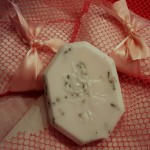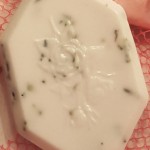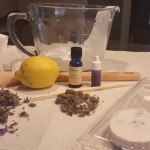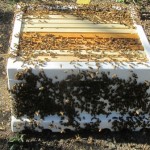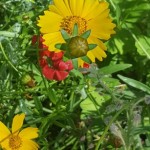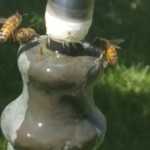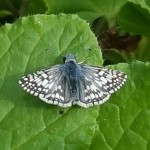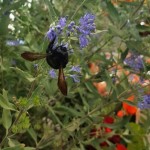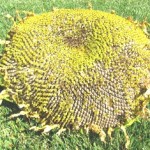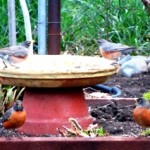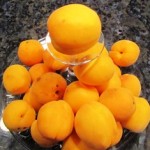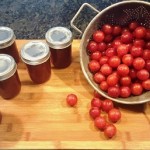Archive for June, 2017
Making Homemade Soap in Under an Hour
My grandmother grew up on a farm in Boone County, Missouri, and from spending a childhood with her I learned how to be frugal, self-sufficient, and someone who values time and efficiency.
On laundry day, she would whip out a big bar of grayish soap she’d made from an old country recipe and use it for scrubbing dirty clothes. The soap contained lye, grease, ammonia, borax, and water.
It looked like an ash-colored cake; I wouldn’t be surprised if it had some ash in it. That soap was utilitarian to be sure, but nothing you’d ever want use for a bath, although I suppose on occasion it might have been used.
Bath soaps have come a long way since the 1920s frugal creations of farm folks like my grandmother. Today, you can find exquisite artisan soaps–many are imported from France, Italy, and elsewhere–in a variety of colors, shapes, sizes, and scents. Or . . . you could make your own.
At hobby and craft stores, you’ll find soap-making kits that provide the basics for making soap in under an hour. You’ll also need some soap color to give your soap an appealing hue (otherwise, the soap comes out white). Finally, drops of your favorite essential oil will give your soap a sensual fragrance.
Recently, the birthday of a friend inspired me to quickly make a few bars of bath soap to wrap and tuck in my “spa” gift package for her. If you haven’t made soap before, start with a kit for soap making such as the one sold by ArtMinds and found in craft stores.
That particular kit uses a goats milk recipe with a suspension formulation that allows additives to float freely throughout the soap. This is important when you want to add to the soap rose or other flower petals or herbs like basil, lavender, or mint. The finished bar of soap lathers luxuriously and leaves your skin feeling squeaky clean.
Lavender-Scented Soap Using the ArtMinds Kit
Ingredients:
1 Goats Milk Soap Kit with 32 scored cubes
1 package of soap-making color (comes with blue, green, and purple); use purple for lavender soap
Lavender essential oil
Plastic sheet of soap molds
*Wooden spoon
*Pyrex glass measuring bowl or microwavable dish
*Do not reuse soap-making utensils or bowls for food service.
Directions:
Remove 10 cubes of “raw” soap formulation. Melt the cubes in a large glass measuring bowl for 30 seconds; if not completely melted, microwave in 10-second increments.
Add drops of lavender color until the desired hue is achieved. Add ten drops of lavender essential oil. Stir to thoroughly mix ingredients.
Pinch off the tiny florets of a sprig of fresh lavender. Drop into the soap and gently blend them in.
Pour the soap to the top of the mold(s). Let set for 20 minutes before removing the hardened soap. I suggest wrapping each soap individually to give as gifts.
For more resources, check out Marie Browning’s book, Natural Soapmaking (Sterling Publishing, NY) or visit Rebecca’s Soap Delicatessen at http://soapdelinews.com/2015/07/how-to-make-cold-process-soap-from-scratch.html
____________________________________________________
If you’re interested in farmette topics and storytelling, check out my Henny Penny Farmette series of mysteries. All three books in the series are available in numerous formats and can be ordered from Amazon, Barnes and Noble, and elsewhere online as well as from traditional bookstores everywhere. See more at http://tinyurl.com/ya5vhhpm
A Hive of Homicides or Hive Demise
The title of the third novel in my Henny Penny Farmette series suggests loss of bees and murderous intent. No beekeeper wants to lose a hive, regardless of how it happens–whether some invader wants to kill the bees, go after the honey, or use the hive as a host for proliferation of its own species.
I’m not one-hundred percent positive why I lost a hive this year. My best guess was that the demise was due (not to homicide but rather) to a tiny little pest, possibly a beetle that weakened it so that the bees and queen fled leading to the hive’s demise.
My beekeeper neighbor and I spotted a small beetle and treated for it. My best efforts to keep my small bee house and the area around it clean as well as doing frequent hive inspections wasn’t enough. Now, I’m considering moving my remaining hive onto a higher, drier, sunnier location.
I’ll do it at night which is the correct time to move bees. You just put a little strip of packing foam along the hive entrance, gently move the hive, and place it in the new location. Remove the foam strip so the bees can leave at dawn and make sure there’s a water source nearby.
The bees will likely accept the move if there is water and food in the area. I like planting perennial bee gardens and flowers and bulbs with high nectar value for bloom throughout the year.
Since hives can be compromised by wax moths, hive beetles, and other pests (as well as parasites and diseases), frequent inspections to decipher a problem and treat it before it destroys your hive is imperative.
With supers (smaller hive boxes with ten frames each) on the hive in June, the bees will forage on abundant flowers and produce honey that can be taken off in July. That’s also the time to inspect for mites because these populations tend to swell during summer.
________________________________________________________________
If you’re interested in beekeeping and other farmette topics, check out my Henny Penny Farmette series of mysteries. All are available to order online at Amazon, Barnes and Noble, and other retailer sites as well as traditional bookstores everywhere.
Plant for the Pollinators
I seldom need an occasion to put in another bed of flowers, but this is National Pollinator Week. I think a new bed is in order to attract local bees, birds, bats, and butterflies–all considered pollinators. Having these small creatures around benefits landscapes, gardens, and orchards.
The U.S. Fish and Wildlife Service has noted that over 75 percent of our plants are pollinated by birds, animals, and insects. We can help ensure these creatures will be around for a long time if we restore their habitats and ensure they have food and water.
There are many lovely plants you can grow that don’t require a lot of care.
- lavender
- bee balm
- echinacea
- sage
- cilantro
- thyme
- sunflowers
- sweet alyssum
- anemone
- borage
- geraniums
- scented pelargoniums
- mint
A tapestry of colorful herbs and flowers beautifies your landscape and pollinators love the diversity. If you don’t have a lot of space, grow some of these plants in planter boxes, clay pots, or other types of containers.
Put in a water feature, too, such as a table-top or larger fountain that recycles water. Even a pottery saucer filled each day can attract pollinators.
It won’t take long for the bees and hummingbirds to find the water. Their frequent visits are fun to watch, and they’ll likely be sipping throughout the day.
_________________________________________________________________________
If you enjoy reading about farmette topics, check out my Henny Penny Farmette series of cozy mysteries from Kensington Publishing. My newest novel includes delicious recipes, tips on keeping bees and chickens, and much more. Click on this URL for more information, http://tinyurl.com/ya5vhhpm
.
Busy Bees and Abundant Rain Spell Bumper Crops in the Orchard
Thanks to the drought-ending rain and the robust activity of our honeybees, my orchard has produced a phenomenal crop of cherries, apricots, and plums this year.
I picked some wild plums today. They’re unusually sweet so I will make them into jam this week. I think the apricots will be ready next week. Today, I’m getting ready for jam-making by taking down cases of canning jars from the storage shelf over the washer and dryer. I’ll need to get lemons, bags of sugar, pectin, and jar lids.
The vegetable garden is also benefiting from bee activity. The summer Italian striped squash and the crooked neck squash plants are producing squash faster than we can eat them. The tomato vines are loaded, and I expect the corn to be ready soon, too.
Nothing beats fresh summer jams to brighten a dreary winter morning. This summer, I hope to make enough to last through 2017 winter into next spring. This past winter, I ran out of apricot jam because it is the one most of our neighbors, family, and friends prefer. But thanks to the rain and the bee activity, running out of jam won’t be a problem for next year.
____________________________________________________
Like my honeybees, I’ve been busy this winter/spring, writing two nonfiction books for readers who embrace the path of yoga, healthy living, meditation, meaningful ritual, and mindfulness. To be released this year: My POCKET MEDITATIONS (July 2017) and MY DAILY RITUALS (Christmas 2017).
Check out MY POCKET MEDITATIONS, the newest forthcoming nonfiction title from Adams Media/Simon & Schuster, at http://tinyurl.com/l6lzorq
![My Pocket Meditations: Anytime Exercises for Peace, Clarity, and Focus by [Lester, Meera]](https://images-na.ssl-images-amazon.com/images/I/51GH%2BXEPc6L.jpg)
COMING SOON: My newest offering in the Henny Penny Farmette mystery series, A HIVE OF HOMICIDES (Kensington Publishing, Sept. 2017).
 Facebook
Facebook Goodreads
Goodreads LinkedIn
LinkedIn Meera Lester
Meera Lester Twitter
Twitter




